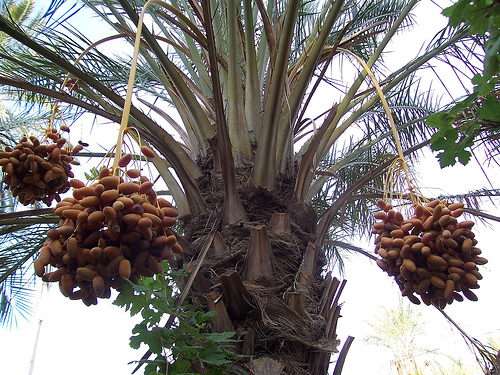
The date is a fruit obtained from the date palm (Phoenix dactylifera). It is believed that it appeared around the Persian Gulf and was cultivated, probably for more than 4000 years, both in Mesopotamia and in prehistoric Egypt.
In recent times, merchants extended their cultivation around South and Southeast Asia, North Africa, Spain and Italy. The dates were introduced by the Spaniards in 1765 in Mexico and California.
The word date comes from the Greek "finger" dáktulos, due to its elongated shape. The dates are cylindrical-oval, from 3 to 7 cm. long, and 2 to 3 cm. in diameter, and when they are not yet ripe, their color oscillates between bright red and bright yellow, depending on the variety. They contain a single seed of 2 to 2.5 cm. long and 6 to 8 mm. thick. This fruit is not subjected to a drying process, but is dried in the sun on the same tree and then harvested.
The bunches of fruit are harvested from the ground, with short ladders, until the palms are 10 to 15 years old and, from then on, with ladders or platforms permanently attached to the trunks.
The date throughout its formation, which comes to be about 5 to 6 months, crosses 4 stages or ages whose names are: Kimri, Khalal, Rutab and Tamar.
A small amount of dates is harvested in the "Khalal" stage (partial maturity) that are yellow or red (depending on the grower), but there are many consumers who consider them astringent (high tannin content). The majority of the dates are harvested in the stages of complete maturity "Rutab" and "Tamar", in which they have higher contents of sugars, a lower humidity, a lower content of tannins and are softer than in the "Khalal" stage.
Given their great variety, the dates are classified as soft (for example: Barhee, Halawy, Khadrawy, Medjool), semi-dry (for example: Dayri, Deglet Nour, Zahidi) and dried (for example: Thoory). The type of fruit depends on its content in glucose, fructose and sucrose.
The Deglet Nour (in Arabic دقلة نور), which means "finger of light", refers to one of the 300 existing varieties of dates. It is said that it is the "king of dates" or "a sun in miniature" because of its golden, translucent and bright color, and its sweet and slightly honeyy taste.
Etymologically, the word degla would come from Dejla, which is the Arabic name of the Tigris, river of Iraq. This variety would have been imported, several centuries ago, from this region.

This variety is cultivated especially in Algeria (in the Zibans sow region of Biskra), Tunisia and the arid states of the southwestern United States (California, Arizona and Texas), where the climate resembles that of North Africa.
According to the Groupement interprofessionnel des fruits tunisiens, Tunisia would be the largest exporter of Deglet Nour, while Algeria would be the world's leading producer of this variety.
The Medjool Date has been called the "king of dates" and the "jewel in the crown of dates". It is the largest, has a fine texture similar to that of a toffee caramel, an exquisite flavor and is very sweet. In ancient times they were carefully cultivated by the people of Morocco to flatter the Arab sheikhs and their relatives, who ranked them as the most delicious of all dates.
The Halawy is an elongated date to which the bone is removed to place a walnut inside, it is called "dromedary date".
The Khadrawy is a round, exquisite, fleshy, soft and moist date.
The Zahidi is a small date that attaches itself strongly to the penca.
The Datil Dayri has a dark brown skin and caramel flavor.
The Barhee variety is quite sweet that is cut into pieces. The Lebanese use it to cook together with the meat.
Dates can be consumed fresh or dried and are a staple food for the inhabitants of North Africa and the Near East, who are the main producers. They contain a great nutritional value that lies in their sugar content, up to 70%, very assimilable. They are also very nutritious for their high content of carbohydrates, iron, potassium, phosphorus, vitamins of group A and B, thiamin, riboflavin, niacin, tryptophan and ascorbic acid.
In North America they are associated with sweet foods and in Arab countries fillings are consumed, candied, distilled, in salads and with couscous. In India they are used to prepare chutneys and curries. Date cakes are prepared in the oases of the Sahara and in other North African countries that are used to feed the caravans. In the Middle East, palm or Toddy wine is made by fermenting the sugar sap extracted from the crown of the date palm.
The dried dates are kept in fresh and dry places for several months, even a year. The soft varieties in the refrigerator are stored for two weeks. The optimum relative humidity of this fruit is between 70-75%.
Nutritional value per 100 g of dried dates without seeds
Energy 280 Kcal 1180 JK
| Carbohydrates | 75 g |
|---|---|
| • Sugar | 63 g |
| • Dietary fiber | 8 g |
| Fat | 0.4 g |
| Proteins | 2.5 g |
| Water | 21 g |
| Vitamin C | 0.4 mg (1%) |
| Manganese | 0.262 mg (13%) |
| % Daily CDR for adults. | |
| Source: Nutrient Database (USDA) | |
